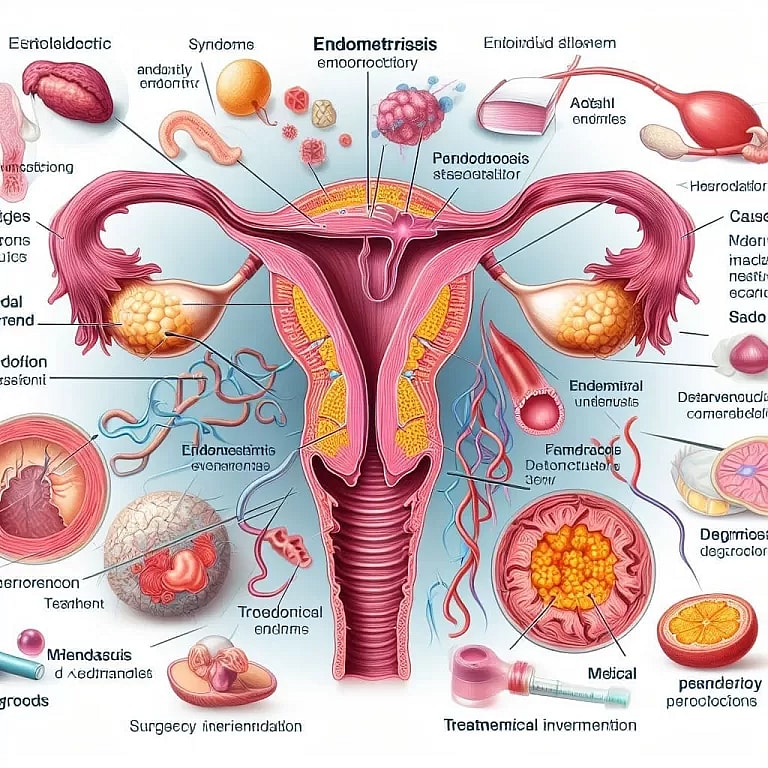What is Endometriosis?
[trp_language language=”en_US”]
Endometriosis is a condition in which the tissue that normally lines the inside of the womb (endometrium) is found inside the abdomen (belly) or in other organs. Endometriosis usually affects women of reproductive age. This tissue outside the uterus causes inflammation and pain. Symptoms include abdominal pain which occurs before or during the menstrual period. Although there is no cure for endometriosis, treatments are usually very helpful in reducing symptoms.
What are the causes and risks?
The causes of endometriosis are still not well understood. It mostly affects people from 25 to 40 years of age. Some factors which are known to increase the risk of having endometriosis include having a close relative with endometriosis, having the first period at a young age, and having long and heavy menstrual periods.
What are the signs and symptoms?
The patches of womb tissue respond to hormones and may cause inflammation or bleeding in the belly and other organs. Because hormone levels go up and down according to the menstrual cycle, the symptoms of this condition change over the course of the menstrual cycle. Symptoms are usually worse during or before the menstrual period. However, some women can develop pain throughout the cycle.
The most common endometriosis symptoms are:
- very painful periods
- heavy and long periods
- deep pain during sexual intercourse.
Some women may have pain when passing urine or having a bowel movement during menstrual periods. This condition is also associated with difficulties in becoming pregnant.
How is the diagnosis done?
The diagnosis is usually suspected based on the medical history and physical examination. Often, an ultrasound of the reproductive organs (the ovaries and the womb) is done to help make the diagnosis. The best way to confirm the diagnosis is to see the inside of the body with a camera (laparoscopy). However, this is only recommended for people who have severe symptoms.
What is the treatment?
Treatment depends on the severity of symptoms and on whether the person plans to become pregnant in the future. Simple pain medications and hormonal contraception are some of the options. Regular physical activity and having a good pattern of sleep can also help. Surgery is usually performed if other treatments are not helpful and is not considered to be a cure for the condition.
What it is the prognosis?
Although endometriosis is an ongoing condition, treatments are helpful in managing symptoms. The symptoms usually go away after menopause. Complications of this condition may include difficulty falling pregnant and the formation of scar tissue within the abdomen.
[/trp_language]
[trp_language language=”ar”][wp_show_posts id=””][/trp_language]
[trp_language language=”fr_FR”][wp_show_posts id=””][/trp_language]
## What is Endometriosis?
Endometriosis is a chronic condition that affects the health of women, occurring when tissue similar to the lining of the uterus (called the endometrium) grows outside of the uterine cavity.
### Symptoms of Endometriosis
The primary symptom is severe pelvic pain, especially during menstrual periods (dysmenorrhea) or ovulation (mittelschmerz). Other common symptoms include:
– Painful bowel movements or urination during menstruation
– Heavy or irregular menstrual bleeding
– Pain during or after sexual intercourse (dyspareunia)
– Infertility
– Fatigue
### Causes of Endometriosis
The exact cause of endometriosis is unknown, but several theories exist:
– **Retrograde menstruation:** When menstrual blood flows back through the fallopian tubes into the pelvic cavity and implants on other organs.
– **Metaplasia:** When cells in the pelvic area transform into endometrial-like tissue.
– **Lymphatic or vascular spread:** Endometrial cells travel through the lymphatic or blood vessels to reach other parts of the body.
### Diagnosis of Endometriosis
Diagnosis usually involves a combination of:
- **Pelvic exam:** To check for abnormal growths or tenderness
– **Ultrasound:** To visualize endometrial lesions
– **Magnetic resonance imaging (MRI):** To provide detailed images of the pelvic area
– **Laparoscopy:** A surgical procedure to examine the pelvic organs and confirm the diagnosis
### Treatment for Endometriosis
Treatment options vary depending on the severity of symptoms and the patient’s desire for pregnancy:
**Medications:**
– Hormone therapy (contraceptives, IUDs) to suppress menstrual cycles and reduce pain
– Pain relievers (nonsteroidal anti-inflammatory drugs, opioids)
**Surgery:**
– Endometriosis excision: Surgical removal of endometrial implants
– Hysterectomy: Removal of the uterus and cervix
### Conclusion
Endometriosis is a common, chronic condition that can cause debilitating pain and infertility in women. Early diagnosis and appropriate treatment are crucial for managing symptoms and improving the quality of life for affected individuals.








***What is Endometriosis? ***